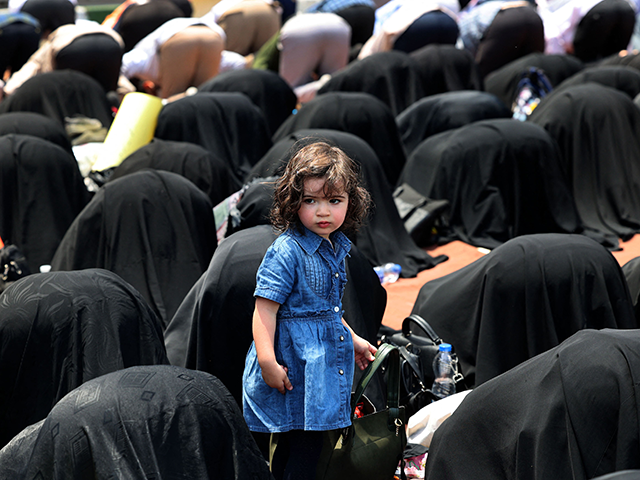The White House said on Thursday that reports of hundreds of Iranian girls in dozens of schools suffering from exposure to toxic gas are “deeply concerning.”
National Security Council (NSC) spokesman John Kirby said the incidents “could be the poisoning of young girls that are just going to school.”
“Truth is, we don’t know right now what caused those ailments. We see reports that the Iranian government is investigating it, that’s the right course of action. We want those investigations to be thorough and complete, and we want them to be transparent,” Kirby said.
“Little girls going to school should only have to worry about learning. They shouldn’t have to worry about their own physical safety, but we just don’t know enough right now,” he said.
Iranian Health Minister Bahram Einollahi said on Tuesday that roughly 800 girls have suffered “mild poison” attacks at over 30 schools in four different cities. At least one of the schools reporting a toxic attack was an elementary school.
The first documented incident occurred on November 30 with 18 victims hospitalized at the Nour Technical School in Qom. Qom is considered a “holy city” by Shiite Muslims, raising suspicions that the poisonings could be the work of an extremist sect that wants to keep girls out of school entirely, much as the Sunni Muslim extremists of the Taliban have banned girls from higher education in Afghanistan.
Some observers, including Amnesty International and Human Rights Watch, believe the attacks could be intended as retaliation for the massive protests against the theocracy that swept Iran after a young woman named Mahsa Amini was killed by “morality police” for not wearing her mandatory headscarf correctly. Female students have been among the most ardent protesters.
“These appear to be serious coordinated attacks to create fear among the girls and their families in the context of girls’ partaking in the protests and being penalized for it. It is adding to the collective trauma and anxiety in Iran,” researcher Tara Sephehri Far of Human Rights Watch said on Thursday.
“It was found that some people wanted schools, especially girls’s schools, to be closed,” Einollahi’s deputy Younes Panahi said last Sunday, seemingly confirming these theories.
Panahi offered no evidence or further details, and Einollahi basically shrugged the entire issue away by stating that investigating origins of the poison is “not within the scope of my ministry.” Panahi later said his remarks had been “misunderstood” and he has no real idea where the poison is coming from.
Some Iranians, including lawmakers and clerics influential with the ruling theocracy, have criticized the government for its negligent response to the poisonings and seeming lack of interest in discovering who the perpetrators are.
“Officials are giving contradictory statements,” complained cleric Mohammad Javad Tabatabai-Borujerdi. “One says it is intentional, another says it is security-linked and another official blames it on schools’ heating systems.”
“You are obliged to ensure my children’s safety! I have two daughters. Two daughters… and all I can do is not let them go to school,” a frightened father cried in a video that went viral on Iranian social media.
Victims of the gas attacks complained of nausea, difficulty breathing, and heart palpitations. Some of the girls have been hospitalized and remained sick for weeks after exposure. The girls have testified they smelled “tangerines” or “rotten fish” before they got sick.
“Dear mothers, I’m a mother and my child is in a hospital bed and her limbs are weak. I pinch her but she doesn’t feel anything. Please don’t send your children to school,” an anguished woman said in another viral video.
The regime in Tehran sought to minimize the problem for months. Einollahi’s statement was among the first official acknowledgments that the attacks were so widespread. Prior statements from Iranian officials suggested there were only a few dozen victims, not hundreds, and downplayed the number of different schools where poisonings occurred.
At a cabinet meeting on Wednesday, Iranian President Ebrahim Raisi assigned Interior Minister Ahmad Vahidi to investigate the poisonings and control news releases about the crisis.
Vahidi is a suspected terrorist linked to the 1994 bombing of a Jewish cultural center in Buenos Aires, Argentina, and he is a former member of the Islamic Revolutionary Guard Corps (IRGC), a designated terrorist organization. Enthusiasm for his investigation from international observers was therefore muted, especially since Vahidi said last week that he thinks “mercenary groups” hired by Iran’s “enemies” are staging the attacks to “cause worry among pupils and families.”
Quite a few critics of the Iranian government expect Vahidi’s “Investigation” to go nowhere because the regime itself is the poisoner:
On Thursday, Vahidi breezily speculated that Iran’s schoolgirls are simply collapsing from “stress and anxiety,” and the poisoning angle was cooked up by foreign media to frighten the Iranian public.

COMMENTS
Please let us know if you're having issues with commenting.